Seals Are an Essential Tool for Rail Transport
Posted by Steve Diebold
Since the beginnings of the US rail system seals have played a key role in securing goods and valuables in transit. In fact the origin of early seal makers, including American Casting, grew largely from the sealing of doors on rail cars, and protecting the property and money inside those cars. At the turn of the 20th century icons like Wells Fargo, Sears and Roebuck and other companies dominated commerce and trade and drove the railroads to more use of security seals. The rest of the world of course developed similar practices for securing their rail cargo.
American Casting was one of the first producers of seals for rail cars, rail cargo, money bags, and strong boxes. Those early seals were lead and wire seals, which were the origin of our company name. Lead seals are “cast” in molds. Hence, the name American Casting & Mfg.
For decades rail cars and their contents were normally secured with lead and wire seals or metal band seals. After World War II railroads began to use a wider range of seals. Especially sought were ways to increase the strength of the seal and provide a barrier to someone committing “quick” theft or vandalism. Mainly pilferage losses were big issue and those thefts took place on cars that were left at sidings or unguarded rail yards. Lighter tamper evident seals are excellent for detecting entry, and are intentionally made to be easily opened with small cutters or knives. It was sufficient to have evidence of opening to help locate the point of theft and catch the criminals. It also satisfied insurance carriers that a loss occurred.
Theft grew and became more widespread and by the 1970s heavier bolt type and cable type seals made of steel came into wide use. Rail carriers wanted and needed the strength of a steel lock on their cars. All seals essentially are a one-time lock.
Around that same time use of intermodal containers on rail cars brought increased awareness of seals beyond just theft and tamper evident functions. They became part of the tracking and tracing for cargo being handed from truck, to ship, to railcars, and back to trucks in a seamless voyage from seller to buyer.
Now, innovations in specialty cars for autos, liquids, bulk dry products, and more have brought a wide assortment of seals into use for rail traffic.
TOP SEALS FOR RAILWAY/INTERMODAL CONTAINER USE
The top choices for seal type vary by the type of car.
Box cars and cars with doors are well suited to a bolt type seal like the AC&M model ISO-1H. These are modern versions of steel bolt seals that can be marked with barcodes, logos and customized informational marks. They also are plastic coated and can be used to identify loads by color. Seals like ISO-1H are certified to meet standards set by ISO for high security use. The same choice applies to intermodal containers stacked on carriers. Bolt seals are the most commonly used type there also.
Hopper cars that carry coal, grain, cement, aggregate other dry bulk product need a flexible cable type seal in order to insert it in the lock mechanism at the opening of each compartment, and to handle the load stress of travel at the bottom of a railroad car. AC&M models CL-99 or CABLELOCK are top choices for those applications.
Tank cars use a range of seals depending on the content and where/how they are moved. Plastic pull-up strap seals like the PS360 or DTZIP are popular for tankers with human consumable liquids and cargo that requires tamper evidence and clear print information over strength. These are used both on the loading hatches on top, as well as discharge valves below. A tanker for high value or hazardous liquids and gas are likely to be sealed with a pull-up cable seal like those used on hopper cars.
While these are not the only seals used in the railroad industry they are the most recognized. For some uses a simple strap seal of plastic can be sufficient. And in the case of empty cars plastic strap seals are preferred for their low cost.
Specialty cargo and flatbeds can be sealed using more unique seals like our model PSW97 Plastic and Wire Seal. This tamper evident seal can be fit through almost any opening and used to tie a load of nearly any length. The unique versatility of this seal is a subject unto itself.
WE CAN HELP
AC&M serves thousands of seal users including government, utility, military, transport, and commercial entities of all types, worldwide. We invite you to utilize and benefit from our 110 years in the seal industry, and our wealth of expertise. Please contact us with questions or further discussion of your needs in seals for any aspect of railroad operations.
An experienced seal applications expert is available during business hours in multiple ways. Contact us at our main office and factory: Email: info@seals.com Call toll free at 1-800-342-0333 in the US or 516-349-7010 from anywhere.
The AC&M web site also offers LIVE CHAT with a seals expert, during US Eastern Time business hours.
Our web site www.seals.com now offers online purchasing of standard or custom seals. You can find all of our locations, full data on our latest products and other useful information. Also FIND all locations, contact information, and full data on all our current products. We are glad to assist with guidance, samples or pricing at your request.

